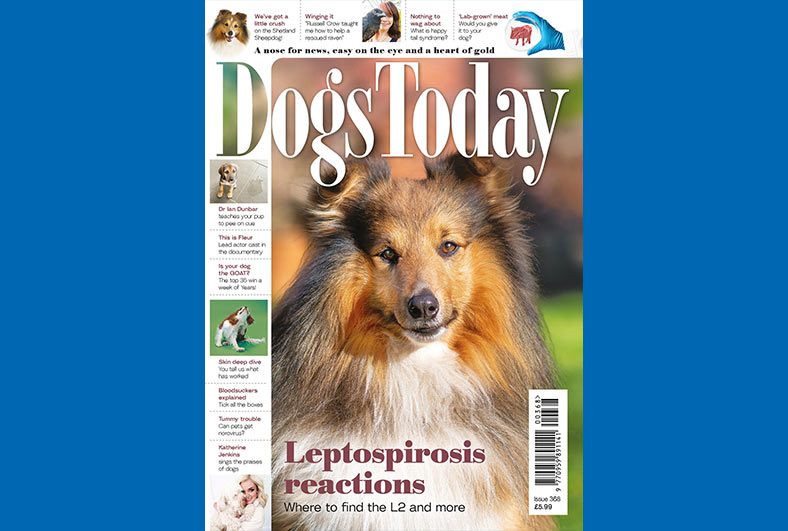Community is key: Media interview with Dogs Today editor Beverley Cuddy

Establishing a magazine publication that lasts is not an easy thing to do in such a competitive market. But after 35 years, or 189 in dog years, Dogs Today has firmly established itself in the magazine world. Also impressive: editor Beverley Cuddy has been in her role for the entire duration (making her the third longest-serving magazine editor, behind Anna Wintour and Ian Hislop).

We caught up with Beverley to discuss her successes and highlights from the last 35 years, the importance of social media, and how community is key.
Dogs Today magazine is celebrating 35 years, what are some of the reasons for its enduring success?
I think dogs are such a central part of our lives and in the last 35 years we’ve seen a huge change. Dogs have become much more a member of the family and the status of a dog has changed and elevated in that time. So inadvertently, we’ve ridden that wave where, when I was a kid, dogs had names like Spot and Fido, and now dogs share the top ten names for babies. In London, there are now more dogs than there are children under five. As a society, dogs have become part of our family. I didn’t realise I was going into a sector that was going to grow and become much more powerful, because people love dogs.
You have also been editor for that duration too. What have been some of your highlights during that time?
Very early on, I made the decision that we should be a campaigning publication. I really admired magazines like Cosmopolitan as they changed things for the working woman. I wanted a dog magazine to do the same for the dog, to be its voice and to change the way the dog is perceived in society.
One of the very first campaigns that we were involved in was inspired by our proprietor, Lord Rothemere. He acquired a dog from a pet shop in New York but couldn’t bring it home to London because of quarantine. We had this very odd system that we would just lock these dogs away for six months and see if they got rabies, and if they didn’t, they could be let out. He thought this was a terrible injustice, so our first job was to get rid of quarantine. It was an enormous task, and took a ridiculous amount of effort to get it moving, but we achieved it. We got pet passports.
The latest one that we did was getting the Pet Abduction Bill through on the last day of Rishi Sunak’s Parliament. There is now a five year criminal sentence if you’re convicted of abducting someone’s pet. That campaign was probably fifteen years in the making, with ten years of seriously pushing for it. However, there are so many campaigns and so many laws that are still on the to do list, we’re only just chipping away at how society needs to reflect that dogs are not a possession. The dog is still not protected in law in enough ways.
What have been some of the challenges that you have faced in this role, and how have you overcome them?
The first challenge was that the magazine wasn’t financially successful. It lost a huge amount of money for Burlington, who was part of associated newspapers, and we were closed after about two years. I then asked if I could buy the magazine and Lord Rothermere was quite amused by it but said he would sell me the magazine for a pound and come in as a minor investor. I then spent the first year changing everything. I made it much more glossy, more pages, more editorial and charged more for the cover, because it was very cheap when it was part of the Mail, and slowed it down to bimonthly so that we could afford to do it. We then won Small Publisher of the Year at the PPA Awards, which was a complete shock.
Another big challenge was when I changed distributors. One of the things that Lord Rothermere put in place when I did the management buyout was that I wasn’t allowed to borrow any money. I had to operate in a positive cash flow. The money that came in from the sales had to pay the printer for the next edition. When I changed over from my old distributor to my new distributor the check wasn’t deposited into the account. That meant everything bounced. I rang up the old distributor and they said they could hold onto that money for six months due to the small print. I thought that was the end of my business but after a few phone calls back and forth, Lord Rothermere started withdrawing the Daily Mail and other publications from this distributor and then the check was with me within an hour!
The Dogs Today Facebook page has over 1 million likes. How important is social media for publishers?
We were very quick to go on to social media. I started a Facebook page for Dogs Today, right at the beginning of Facebook, and very quickly I realised how powerful that was. As you said, we’ve got over 1 million likes and 1.3 million followers now on our Facebook page. On my own personal Facebook, I’ve probably got 31,000 followers, but that’s a really hardcore 31,000 serious dog lovers who are properly embedded into the dog world somewhere or other, and have been accumulated over 35 years.
If there’s ever an emergency in the dog world, you can put a call out on social media and the action is powerful and swift, and things are sorted out. It was very early on that dog lovers found their voice and found their power when they unite on social media. The number of petitions through Parliament that have reached 100,000 signatures in record time on dogs is totally out of scale, because these are people who have got something so powerful that unites them, the love of dogs, the feeling that we must protect them.
What does the magazine do to foster that community mentality?
Back in the 90s, we were involved in a campaign for change, where one woman pointed out that we don’t vaccinate ourselves against tetanus every year, so why are we vaccinating our dogs every year? These vaccines last longer than a year, and this one woman stood up to the whole big pharma industry and challenged it. World in Action did a documentary based on it, and then the world small animal Veterinary Association changed all the rules and decreed that we didn’t need to do it annually anymore and that these vaccines lasted at least three years, maybe longer. One woman changed the whole thing, but we amplified the voice.
Occasionally, the ‘little’ people can all get together and look over the shoulder of the big industries and the big bodies, and you can join all those voices together to get change. I think the magazine’s job is to join people together. We need to sift through all the rumour and speculation and try and find the facts. Then we give people the facts and help them make up their own mind, and then support all the people who’ve got anything to do with dogs.
February’s issue won ‘Cover of the Month’ from the BSME, how valuable is having a print offering (and an alluring front cover to get people’s attention)?
Some people still love it. A few years back, we had a flash flood where everything was ruined in our office and we lost all our bound copies of the magazine. I wrote about it and eight different readers got in touch saying they had every single edition and they were prepared to give them back, and that really warmed my heart. But it shows that the physical magazine, especially if your dog is in it, is something you want to keep.
There will always be some people who want the physical magazine and I’d be sad if we stopped doing that. Some people that have been in the magazine, like Davina McCall, that front cover is framed and on her wall still because it’s important when it’s you and your dog.
However, people’s habits have changed considerably in our 35 years. We’ve had to be nimble and we were very quick to go digital. We were the first pet magazine in Europe to go onto an iPad. We’ve gone from being a model where you get a huge amount of revenue from your cover price and really that contribution is negligible as the magazine is free to read from three weeks out, digitally, forever. That means we reach many more people than ever before because we’re now international.
How did you get into journalism and what is your advice for anyone looking to get into the industry?
I completely fell into it by mistake. At University, I did my dissertation on the concept of cruelty in Victorian England and part of that was researching what they did to dogs. I then had to sit in the weekly newspaper of Our Dogs in Manchester, because they had all the books about the history of dogs in Britain. They offered me the chance to write for them while I was doing the dissertation and that forced me to learn how to write. I then spent a year as sub editor at Dog World down in Kent, before getting a job at the kennel club in London as their information officer and after a few years I strayed into doing their magazine, which was the Kennel Gazette (an in-house magazine for members).
After four years, I moved to a corporate magazine for British Telecom. They gave me lots of training, including how to use desktop publishing just as it was starting. However, that wasn’t where my passion was and after a year, one of my colleagues spotted the job advert to be launch editor at Dogs Today. So that would be my advice to aspiring journalists, to find your niche and do absolutely everything possible in that niche. Then you become that person who can answer any question at all on that niche subject. I’ve always tried to be a friend to new journalists and equally to busy people who just need your help. Always be empathetic and helpful, because life is a lot easier if we all pull together and help each other.
Does the magazine work much with PRs and if so, what kind of contributions do you find relevant?
I love to work with PRs. I like being more involved in what their objective is or what the client’s objective is. I don’t like being sent a press release and just being asked to print that. Currently I’m working on a piece around car safety and apparently the research shows that the youngest generation have not given any thought to the safety of their dogs that they’re transporting. That to me is a really big campaign to get involved in. I don’t want a press release that tells me about a car seat that a dog can sit in. I want to look at the figures for how many children died before it became the law that you had to put them into a safety seat and then we can look at if we change the way transports our pets, how many lives would be saved? That to me is proper journalism. So if you’re a PR then involve me at the beginning and we can have a little round table discussion because I love coming up with campaigns.

